#Greg Lecoeur
Explore tagged Tumblr posts
Photo

By holding their breath, scalloped hammerhead sharks may be able to regulate their body temperature when diving thousands of feet below surface waters.
PHOTOGRAPH BY GREG LECOEUR
#greg lecoeur#photographer#national geographic#scalloped hammerhead shark#shark#animal#marine#nature
158 notes
·
View notes
Photo
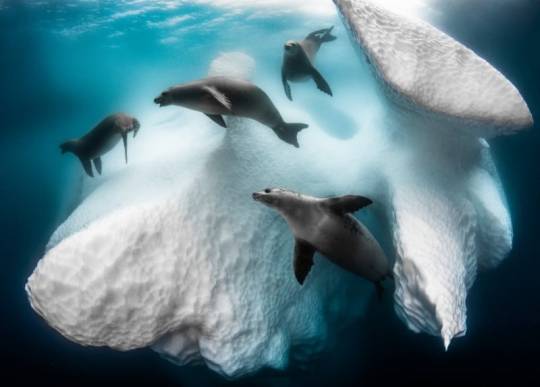
Photo ©Greg Lecoeur | UPY 2020
(via Photo of Seals 'Living' in an Iceberg Wins Underwater Photographer of the Year 2020 | PetaPixel)
64 notes
·
View notes
Text

By holding their breath, scalloped hammerhead sharks may be able to regulate their body temperature when diving thousands of feet below surface waters. Photograph By Greg Lecoeur
Do Sharks Hold Their Breath Underwater? This Species Might.
The “completely unexpected” behavior reported in scalloped hammerhead sharks raises questions about how widespread it may be among other species.
— By Dina Fine Maron | May 11, 2023
Scalloped hammerhead sharks may be holding their breath when they dive deep into frigid waters. The revelation, published today in Science, suggests that this strategy may allow the warm-water dwellers to regulate their temperature while they hunt.
This technique is “completely unexpected,” says Mark Royer, a shark biologist at the University of Hawaii who led the research. “This kind of behavior has never been observed in any kind of deep-diving fish,” he says, and it now raises questions about how widespread breath-holding may be among other species.
These critically endangered hammerhead sharks typically rely on forward movement to force water across their gills, which enables them to extract needed oxygen to breathe. Yet when the predators swim half a mile down to catch squid and other prey, the colder water could impact their metabolism, cardiac function, and eyesight—all factors that would reduce their hunting prowess.
By closing their gills and mouths—holding their breath—the animals could limit their exposure to cold water.
Some species, like bluefin tuna and mako sharks, have specialized anatomy that allows them to conserve their body heat in cold waters, but scalloped hammerheads don’t have that advantage.
That’s why some scientists have theorized that scalloped hammerheads maintain their body heat using simple thermal inertia—essentially relying on their large body size to help maintain their temperature and carry heat down as they dive into cold depths.
“Imagine you are trying to defrost your 15-pound Thanksgiving turkey: you bring it out of your freezer, and it takes a long time to thaw—that’s like thermal inertia,” says Marianne Porter, a biologist who studies shark movement at Florida Atlantic University and wasn’t involved in the study.
Yet tiny sensors that the team placed on adult scalloped hammerhead sharks—basically a “Fitbit for sharks” as Royer says—suggest that thermal inertia isn’t the reason they remain warm during their hunting trips at depth.
Hunting in Frigid Waters
For the study, the team analyzed detailed information about the swimming behavior, depth, and location of a small group of six tagged male sharks that collectively completed more than a hundred dives around Hawaii over several weeks.
Tiny probes also recorded the animals’ muscle temperatures during these repeated nighttime dives. That data, alongside further modeling, indicated that the sharks managed to largely maintain their body temperatures both when they were at surface waters around 80 degrees and when they plunged to more than 2,500 feet below where temperatures dropped by roughly half, to around 41 degrees.
Surprisingly the animals’ body temperatures did eventually drop when they had ascended and reached slightly warmer waters about halfway back to the surface—apparently when the sharks had opened their gills to obtain needed oxygen. That’s not what you would expect with thermal inertia, since there’d be a more constant warming and cooling to reach equilibrium, Royer says.
Though they didn’t observe the sharks actually closing their gills, his team suspects that’s what’s happening. To fully confirm their breath-holding hypothesis, Royer says, they will next need to affix cameras to the pectoral fins of these hammerheads to observe the gills opening and closing as sharks dive.
It’s still unclear how the 12-foot-long species may have acquired this breath-holding skill. “It’s possible they learn it from social interactions from other hammerheads that are diving,” says Royer, adding “another possibility is they’re following the example of other animals that dive and eat prey at the same depth.”

A school of scalloped hammerhead sharks navigates deep water near Costa Rica’s Cocos Island. The sharks sometimes dive thousands of feet below the surface in search of squid, fish, and other prey. Photograph By Greg Lecoeur, National Geographic Image Collection
Compelling Evidence
Further backing the team’s breath-holding conclusion: prior footage from a remotely operated vehicle that shows an adult scalloped hammerhead shark swimming in Tanzania at more than 3,000 feet below the surface with its gills closed, and footage of the species in its typical surface waters with open gill slits. What’s more, another experiment from Royer’s team with deceased hammerheads in warm and cold water baths also supported their results.
“It’s a compelling paper—the way they have all these lines of evidence suggesting this might be happening,” says Porter. “I’m convinced” there’s breath-holding, she says.
Female scalloped hammerhead sharks also conduct deep dives, she says, so though this study only included males she suspects this applies to non-pregnant females as well.
The implications of this breath-holding work are “remarkable,” write the University of Western Australia’s Mark Meekan and Murdoch University’s Adrian Gleiss in an accompanying scientific commentary also published in Science.
If these rapidly declining species can pause respiration while foraging at depth they may cope with the increasingly common low-oxygen environments in our changing world better than expected, they write. Already, scalloped hammerheads occupy low-oxygen waters in the Gulf of California, and this newly discovered breath-holding skill may explain their presence, they note.
It's true that these animals may survive in low-oxygen areas for short periods, Porter says, but that’s likely not sustainable long-term. “I would wonder what happens if that becomes their reality all the time.”
6 notes
·
View notes
Text

Un gruppo di globicefali, cetacei appartenenti alla famiglia dei Delphinidae, ma dal comportamento che ricorda quello delle balene
Foto: © GREG LECOEUR/UPY 2016
1 note
·
View note
Text

Frozen Mobile Home. Antarctic Peninsula. By Greg Lecoeur. Nice, France.
Greg Lecoeur is a wildlife photographer who uses the art of digital storytelling to raise awareness about ocean conservation. Growing up on the French Riviera, Lecoeur learned to scuba dive in the Mediterranean Sea where he developed his passion for the marine world and underwater photography.
Lecoeur was named Nature Photographer of the Year in 2016 by National Geographic. big Picture Photography Awards #frozen #mobile #home #antarctica
1 note
·
View note
Photo

📢 [ÉCHO] 🍃 Au printemps dernier, je suis parti au Costa Rica 🇨🇷 - nation verte d'Amérique centrale 🦋🐛🕷 - avec le photographe Greg Lecoeur. Retrouvez notre reportage au cœur d'un pays curieux de nature 🦠🦟🌿🐋🦈 dans Le Figaro Voyages de ce week-end.
Pour les abonnés au journal Le Figaro, notre reportage intégral 🍃 est à découvrir sur https://www.lefigaro.fr/voyages/inspiration/carnet-de-voyage-au-costa-rica-curieux-de-nature-20211105
#Costa Rica#parcnational#volcano#volcan#nature#Forêt#biodiversité#photographe#greg lecoeur#récit#stéphane dugast#enquête#voyage#journal#le figaro#le figaro voyages
2 notes
·
View notes
Photo

“Biodiversity”, False Bay, Simon's Town, South Africa,
Echinoderms form a branch of benthic marine animals present at all oceanic bottoms. They constitute a very important part of benthic fauna with a very rich diversity of up to 7000 species related in 5 classes: tarfish, sea urchins, sea cucumbers, feather stars and brittle star. And therefore play a major role in the biological processes of the marine environment, particularly with regard to the recycling of waste by their detritus feeders or filter feeders.
Greg Lecoeur Photography,
Underwater Photography Guide
#art#photography#underwaterlife#underwaterphotography#biodiversity#nature#sea#ocean#life#reef#reefscapes#greg lecoeur#oceanartcontest#aquatic life#marine life#underphotographyguide#south africa#simon's town#urchin#tarfish#recycling
242 notes
·
View notes
Photo

Description of this photograph from Mother Nature Network:
While waves may roil and sunlight might dance atop the water, often the most interesting activity happens underneath the surface.
Since 1965, the Underwater Photographer of the Year awards have been focused on this fascinating underwater realm. The competition "celebrates photography beneath the surface of the ocean, lakes, rivers and even swimming pools." Winners are selected in 13 categories including up-and-coming photographers, marine conservation and British photographers.
French photographer Greg Lecoeur is this year's Underwater Photographer of the Year, winning with the image above. His photo earned top honors out of 5,500 entries from photographers from 70 countries.
Called "Frozen Mobile Home," his image features a group of crabeater seals swirling gracefully around an iceberg in Antarctica. It also won in the Wide Angle category.
"Massive and mysterious habitats," explains Lecoeur, "little is known about how wildlife thrives around these mobile homes. Icebergs fertilize the oceans by carrying nutrients from land that spark blooms of marine life and also provide homes for larger animals, like these crabeater seals."
84 notes
·
View notes
Photo

Bird photographer of the year 2020, Bird Behaviour Silver Winner:
Feeding frenzy by Greg Lecoeur, France
9 notes
·
View notes
Photo

FROZEN MOBILE HOME
CRABEATER SEAL (Lobodon carcinophagus)
Icebergs are dynamic kingdoms that support marine life and fertilise the oceans.
Crabeater seals live on the pack-ice.
Antarctic Peninsula, Antarctica
Photo Credit: Greg Lecoeur, France
AG Nature Photographer of the Year 2020: Animal habitat shortlist
#greg lecoeur#photographer#ag nature photographer of the year 2020: animal habitat shortlist#crabeater seals#seals#marine photography#antarctic peninsula#antarctica#france#icebergs#australian geographic#nature
159 notes
·
View notes
Photo

Wide-angle category - winner. Humpback whale spy hopping by Greg Lecoeur (France). Location: Vavau’ , Tonga
Tonga offers probably the best opportunity to interact with humpback whales in blue water. The judges commented: “An amazing subject, caught at the precise peak of the action. Greg’s split level is an image that truly justifies being a split level. The gesture of the humpback reaching out with its pectoral fin completes the moment.”
Photograph: Greg Lecoeur/UPY 2018
#nature#wildlife#animals#wide-angle#underwater#photography#humpback whale spy hopping#humpback whale#whale#ballena#spy#greg lecoeur#san francisco#frank castle#vavau#tonga#nemo#just keep swimming#blue wave#water#ocean#amazing#peak#perfect moment#attraction#split#fin#moment#upy 2018#into the wild
594 notes
·
View notes
Photo

Greg Lecoeur - Humpback whale spy hopping
1 note
·
View note
Text
Beautiful Moments Between Animal Mothers and Their Babies!
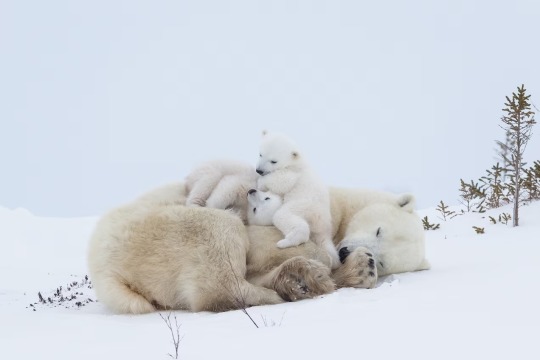
A Polar Bear Mom rests after nursing in Wapusk National Park in Manitoba, Canada. Polar bears mate in the spring but don't become pregnant until the fall. Then, only those females who've successfully fattened up over a summer of hunting will begin to bear young. During those months of plenty, a bear may gain more than 220 pounds, and mothers need every bit of those reserves when it's time to den. Depending on where in the Arctic they call home, polar bear moms may remain in their snowy dens for up to eight months without eating or drinking. Cubs, often twins, spend their several months in their den, enjoying their mom's high-fat milk. Moms dote on their cubs for two to three years, protecting them from threats including male polar bears. They also teach them the skills needed for life on the ice, including how to swim, hunt, and prepare dens for their own future families. Photograph By Norbert Rosing, National Geographic Image Collection
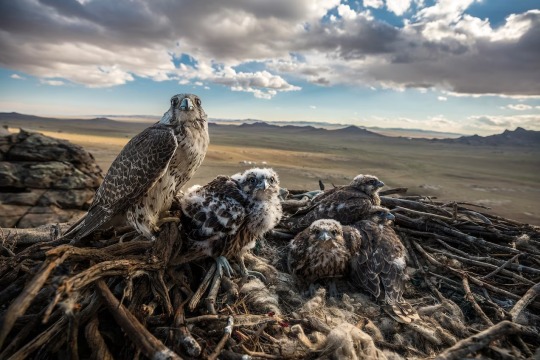
A Saker Falcon and her Chicks, known as Eyases, take in the panoramic view across the vast expanse of the Mongolian plain. Mothers raise their young in existing nests f built by storks, eagles, or other birds, says Per Smiseth, a University of Edinburgh behavioral ecologist. This particular falcon mother sat on her eggs for over a month, never leaving the nest, while her mate brought her food. Both parents care for their noisy young, which fledge after about 50 days. Smiseth notes that this kind of family-focused lifestyle is far more common among birds than among most other animals. "Birds are typically very good parents," he says. Photograph By Brent Stirton, National Geographic Image Collection

Humpback whales have a calf only every two to three years and lavish it with attention. Young whales nurse for an entire year and keep growing for 10. During this time, mother and offspring travel thousands of miles from their calving grounds in tropical waters to rich summer feeding grounds in the temperate and polar seas. The whales, pictured above frolicking near Vava'u, Tonga, spend winters in Antarctica, while some North American whales journey from Alaska to Hawaii. A main threat to the calves during such journeys are orcas, also known as killer whales. That's why the pair sometimes communicate by whispering, which allows the mom to keep tabs on her calf while staying under the radar. Photograph By Greg Lecoeur, National Geographic Image Collection
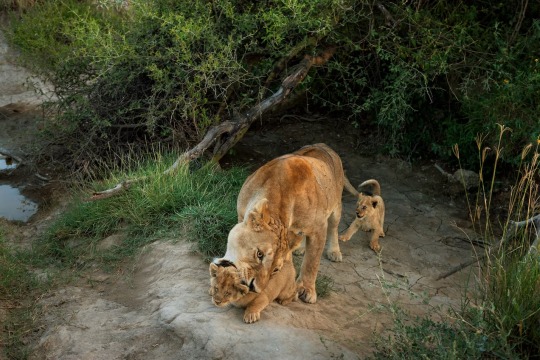
Unlike most of their famously aloof kin, African lions are social cats. They live in prides dominated by related females, like this cub-wrangling mom in Serengeti National Park, Tanzania. "Females are the core. The heart and soul of the pride. The males come and go," Craig Packer, director of the Lion Research Center at the University of Minnesota, told National Geographic in 2019. Female lions hang together to protect themselves from dangers, including male lions, which will kill cubs of competing males. They form a communal nursery called a crèche, and even groom and nurse each other's cubs (though they always prioritize their own). Young lions are playful, but they don't begin hunting until they are about a year old. This means they generally eat last, and competition over food, as well as infanticide, mean that many cubs are unlikely to make it to adulthood. Some scientists estimate that only half of all cubs make it to age two. Photograph By Michael Nicolas, National Geographic Image Collection

An Emperor Scorpion, one of the World's Largest Scorpions, carries her immature offspring on her back. "Scorpions may get some bad press, but female Scorpions are very attentive parents," Smiseth says. Emperor scorpion mothers give birth to an average of nine to 32 fully formed young. These ghostly white newborns are completely dependent on their mother for the first few weeks after birth. The young don't need food, as they subsist on nutrients left over from the embryo stage until they can hunt for themselves. All scorpions practice parental care, which is perhaps why they've been around for hundreds of millions of years and live on every continent except Antarctica. "Scorpions were among the first animals to colonize dry land, and female care might be part of the key to why they were able to do that successfully," Smiseth says. Photograph By Zssd, Minden Pictures
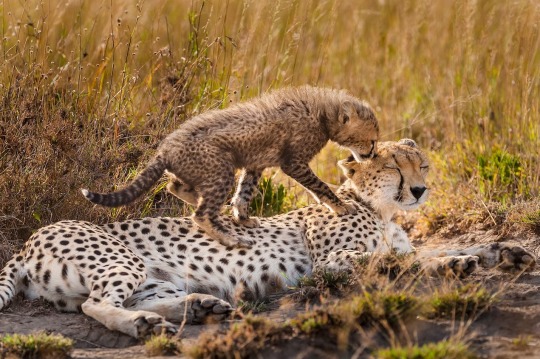
A cheetah family slows down for a bit of play in Serengeti National Park, Tanzania. Being a cheetah mom is very hard work: During the early weeks of her cubs' lives, the mother must move them every few days to avoid predators. If all goes well, cheetah siblings stay with their mom for about a year and a half, learning to hunt. The young cats then try out their independence by hanging together as a group for another six months or so. Some cheetahs are supermoms, not only raising their own young but fostering the cubs of others. "I'm not aware of any other carnivore whose survival relies so heavily on the success of so few females," Sarah Durant, director of the Serengeti Cheetah Project, told National Geographic in 2012. Durant adds one notable female, named Eleanor, had mothered 10 percent of the southern Serengeti's adult cheetahs. Photograph By FransLanting, National Geographic Image Collection
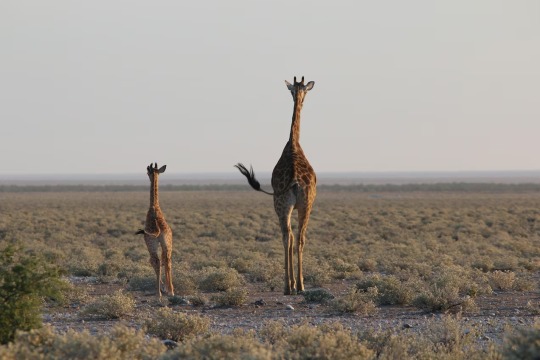
An Angolan Giraffe Mother and Calf greet the dawn on the plains of Namibia. Giraffe calves are born famously well suited for life on the run, standing within 30 minutes of birth. It’s critical that they do so, as newborn calves are a favorite meal of many African predators. But before these “mini-adults” are born, mom has to endure a 15-month pregnancy, which allows for the development of a six-foot-tall baby with strong muscles and nervous system. When their calves get a bit older, female giraffes will sometimes call on “babysitters,” Verdolin says. “The mothers hang out together….The females leave their calf with another mom, and it’s sort of like a giraffe calf playgroup. It’s also community support for the mothers.” Photograph By Madelaine Castles, National Geographic Image Collection

A Female Gray-headed Flying Fox hangs with her young in a riverside colony in Yarra Bend Park, Victoria, Australia. Mothers typically a single pup at a time, which initially can’t regulate its own body temperature. During this time the mother wraps her young in her wings. When she ventures out at night to feed on fruits, pollen, and nectar, the pup clings to her, clawing her fur and clamping its mouth around her nipple. When pups are older, yet still too young to fly, they’re left behind in the colony’s trees. When Mom returns with nourishment, she and her pup recognize one another among the group by scent and the sound of each other’s calls. Photograph By Doug Gimesy, Minden Pictures

A Giant Panda Mom cradles her Cub at the Wolong Conservation and Research Center in China. The cubs are born famously tiny—just 1/900th the size of their mothers—and are blind, hairless, and totally dependent on Mama. Pandas often have twins, which means panda mothers must choose which of the pair is most likely to survive—and devote all her efforts to that cub at the expense of the other. So while practice of abandoning a less fit twin might land pandas on some lists of the animal kingdom's "bad moms," they are actually trying to be the best mothers they can. It's not that panda moms aren't devoted. For months after birth, she holds her cub almost nonstop to share body warmth and nurse. She rarely leaves the den, even to eat and drink. Photograph By Ami Vitale National Geographic Image Collection

Mamas and Babies: Like super human moms, great animal moms show grace to their young, feed them when they’re hungry, teach them the ropes... and some even sacrifice themselves so their offspring may live. (Pictured above, a Gorilla carries her Newborn.)
0 notes
Text

Crab-Eater Seal è la foto vincitrice della sezione principale - Best Show - dell'Ocean Art Underwater Photo Competition 2019, il prestigioso concorso fotografico che esplora la vita degli abissi, affascinante, ma ancora per lo più sconosciuta. Il fotografo Greg Lecoeur ha sorpreso questa "foca dei granchi" che cerca di nutrirsi, in un ambiente sempre più ostile alla vita a causa dello scioglimento dei ghiacci
Foto: © Ocean art 2019/ Greg Lecoeur
0 notes

